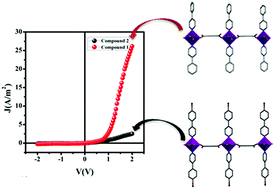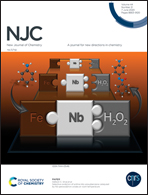Linear dicarboxylate-based pyridyl-appended cobalt(ii) coordination polymers in search of opto-electronic properties†
Abstract
Two new coordination polymers (CPs), namely [Co(adc)(4-ppy)(H2O)2]n, (1) and [Co(adc)(4-bppy)(H2O)2]n, (2) (H2adc = acetylenedicarboxylic acid, 4-ppy = 4-phenylpyridine and 4-bppy = 4-(4-bromophenyl)pyridine), have been synthesized and characterized via numerous techniques including elemental analysis, infrared spectroscopy, powder X-ray diffraction (PXRD), single crystal X-ray diffraction (SCXRD), and thermogravimetric analysis (TGA). Both the compounds form one-dimensional (1D) chain-like structures constructed by linear dicarboxylate and pyridyl-based organic linkers and show significant non-covalent interactions. Both the compounds exhibit electrical conductivity and reveal Schottky barrier diode behavior. However, compound 1 shows a slightly better electrical conductivity (2.61 × 10−5 S m−1) than compound 2 (2.52 × 10−6 S m−1). The optical band gaps of both compounds in the solid state have also been determined via experimental measurements and compared with the theoretical values obtained from DFT calculations.



 Please wait while we load your content...
Please wait while we load your content...